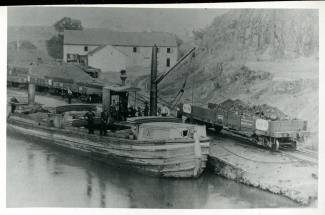Collection Name
About
Wharfs were designed to facilitate the loading and unloading of canal boats and grew up along the line of the canal wherever the need emerged to transship cargo from land to boat or visa versa. Typically the wharfs would be on the berm of the canal, and consisted of a stone wall and other facilities for the storage and transfer of cargoes.
The Cushwa coal wharf was one of the largest and most active on the C&O Canal, and served not only local needs, but customers that could be served by using the Western Maryland Railroad once its branch line reached the wharf. Over the years a variety of machines were built on the wharf to lift coal from the boats to rail cars or nearby storage piles. Boats, however, varied little once the standard canal freight boat was developed.
One change that did occur was the emergence of steam freighters, beginning in the 1830s but it was sporadic because of company financial problems. By 1850 N.S. Denny & Co. was operating a fleet of steamboats on the canal, and by 1876 there were sixteen (Jackson). The use of steam boats peaked in the 1870s—the canal’s heyday—and in 1879 there were nineteen such boats operating on the canal. From time to time steamboats that carried passengers were also operated on the canal. One such boat, the Flying Cloud, which could carry both passengers and light freight, operated in the early 1860s until burned by General Jubal Early’s Confederate troops during his invasion in July 1864.
In this photograph the boiler stack can be seen at the stern of the boat along with a steering wheel instead of a tiller. The panels of the cargo holds are seen stacked up and coal can be seen still in the rear hold. Coal is being loaded onto a Western Maryland railcar. There is also a steam engine powering the stiff legged derrick to lift the coal from the boat into the waiting coal car.
From the collection of the Western Maryland Railroad Historical Society.
R. P. Jackson, The Chronicles of Georgetown, D.C., from 1751-1878; Washington DC, R O Polinhorn Printer, 1878.
See also Cushwa and Sons, 1898 -Bill for Georges Creek Coal
